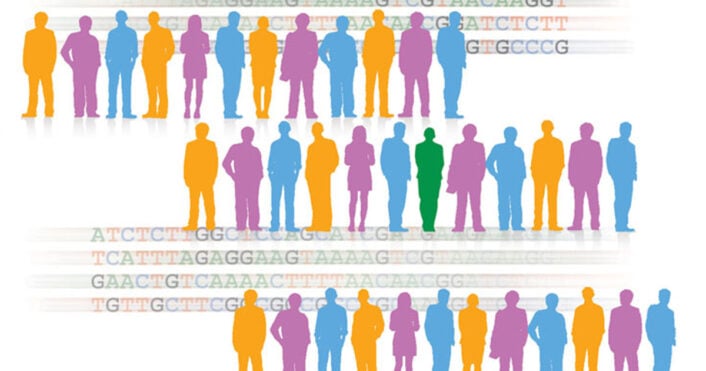
In a world that increasingly values personalization, from customized shopping experiences to personalized medicine, genotyping has emerged as a vital tool in decoding the most intimate information of all – our genetic makeup. But what exactly is genotyping, and why does it matter? In this article, we will answer these questions about genotyping. We will also discuss its applications and implications for the future.

Genotyping is the process of determining the genetic variants an individual possesses. In simpler terms, it is like reading specific sections of people’s DNA to find out more about their genetic similarities and differences. The genetic differences or variants (or polymorphisms) can be as small as a single nucleotide, the basic unit of DNA, or larger segments of your DNA spanning thousands of nucleotides.
There are several types of polymorphisms that are commonly analyzed during genotyping. Here’s a table outlining the most common types:
Type of Polymorphism | Description | Example |
Single Nucleotide Polymorphisms (SNPs) | Variations at a single base pair. The most common type of genetic variation among people. | |
Insertions/Deletions (Indels) | Addition or removal of base pairs in a gene. It can be small (a few bases) or large. | |
Copy Number Variants (CNVs) | Variations in the number of copies of a particular gene or DNA segment. | Variation in the number of the AMY1 gene (associated with starch digestion) |
Microsatellites or Short Tandem Repeats (STRs) | Repeated short sequence motifs of 2-6 base pairs. | Used in DNA fingerprinting |
Minisatellites or Variable Number Tandem Repeats (VNTRs) | Larger sequence motifs (10-60 base pairs) repeated many times. | Used in DNA fingerprinting and paternity testing |
Transposable Element Insertions | Sequences that can move around and insert themselves into different parts of the genome. | |
Inversions | A segment of DNA is reversed end to end. |
These various polymorphisms are often targeted during genotyping because of their potential to impact gene function, disease risk, or other phenotypic traits. Different genotyping platforms and techniques may focus on different subsets of these polymorphisms, depending on the purpose of the study or test.
The genotype and phenotype are foundational concepts in genetics, each representing different aspects of an organism’s traits. The genotype refers to the specific gene variants and other unique sequences an individual carries in their DNA. Genes especially contain the coded instructions for every characteristic an organism can inherit. In contrast, the phenotype describes observable characteristics or traits of an individual that arise from the interaction of the genotype with the environment.
Consumer genetic testing has become a popular trend in the past decade. From discovering your ancestral roots to getting insights into potential health-associated risks, these tests promise a wealth of information about your genetic makeup. At the core of these consumer-oriented tests is the genotyping technology that is used for analyzing the consumer’s DNA sample typically for simple polymorphisms such as SNPs and Indels (see above). But what does genotyping in consumer genetic testing involve? Let’s delve into it.
Ancestry and Genealogy
One of the most popular reasons people turn to consumer genetic tests is to explore their ancestry. Genotyping helps to identify specific markers in DNA associated with particular ethnic or regional groups. By analyzing these markers, companies can provide users with a breakdown of their ethnic composition and potentially connect them with distant relatives who have also taken the test.
Health Profile and Disease Risk
Genotyping is used to identify genetic variants associated with specific health conditions or diseases. By assessing these variants, consumer genetic tests can provide individuals with information about their predisposition to certain health-associated risks, from conditions like Alzheimer’s disease to lactose intolerance. It’s important to note that if a genetic marker is present it does not guarantee the onset of a condition but indicates an increased risk.
Pharmacogenomics
Genotyping can provide insights into how an individual might respond to certain medications. This field, called pharmacogenomics, studies how genetic variations affect drug metabolism and efficacy. Consumer genetic tests may offer information about potential drug sensitivities or the likelihood that a medication will be effective for a particular individual.
Traits and Personal Attributes
Beyond health and ancestry, genotyping can also shed light on various personal traits. For instance, some tests might reveal genetic markers associated with the likelihood of having freckles, or even a predisposition to prefer sweet over salty flavors. These insights add an extra layer of personal discovery for users.
Explore LifeDNA’s Sleep, Skin, and Personality Report
Nutrition, Supplements, and Fitness
Some consumer genetic tests focus on nutrition and fitness, offering insights on these aspects of daily life based on genotyping results. These tests might provide information about an individual’s propensity to gain weight, how they metabolize different nutrients, or their genetic predisposition towards more benefits from endurance versus strength training. Utilizing this information, you can tailor your diets and exercise regimes to your genetic strengths and weaknesses.
Explore LifeDNA’s Nutrition and Fitness Report
Carrier Status
Genotyping can also offer valuable insights for couples planning to have children. Some approved consumer tests analyze genes associated with hereditary conditions, helping prospective parents understand the potential risks of passing these conditions onto their offspring. These types of test results should always be confirmed by appropriate clinical testing laboratories.
Neanderthal DNA
In addition to providing insights into more recent ancestry, some genetic testing companies, like 23andMe, analyze an individual’s DNA for traces of Neanderthal ancestry. Our ancient cousins, Neanderthals, interbred with modern humans thousands of years ago. As a result, a portion of the DNA of non-African populations today is derived from Neanderthals. Genotyping can determine the percentage of Neanderthal DNA an individual has, and even associate certain traits or health implications with this ancient DNA.
23andMe, one of the leading consumer genetics companies, primarily uses SNP genotyping to analyze an individual’s DNA. Specifically, they utilize a custom-designed microarray chip to probe and read hundreds of thousands of specific SNPs across the genome. This microarray technology allows them to scan the DNA for specific known genetic markers (SNPs) and report on those variants.
The advantage of SNP genotyping via microarrays is that it is cost-effective and can simultaneously provide information on many genetic variants. However, it’s worth noting that this method only tests for pre-determined SNPs that are present on the chip. It does not sequence the entire genome, only providing information on a subset of an individual’s genetic variants.
In consumer genetic testing, this approach is sufficient for most purposes, like ancestry analysis or determining genetic risk factors for certain diseases, traits, or conditions the company includes in its reports.
Genotyping is poised to become faster, cheaper, and more precise as technology advances. This can lead to more widespread use, not only in specialized fields but also in everyday medical practice. Moreover, as the wealth of data from genotyping grows, our understanding of genes and
their influence on diseases, traits, and behaviors will also expand. It promises more personalized and effective healthcare, with treatments and medicines tailored for individual genetic profiles.
However, with these advancements come ethical considerations. We must address privacy issues, the potential misuse of genetic information, and questions about ownership of genetic data.
You may also like: 31 Frequently Asked Questions About Genetic Testing.
Genotyping offers a fascinating glimpse into the blueprint of life. While it’s a powerful tool with tremendous potential, it is essential to approach it with a clear understanding and respect for the information it reveals. As we stand on the cusp of a genomics revolution, genotyping will undoubtedly play a central role in shaping the future of medicine, agriculture, and many other fields.
*Understanding your genetics can offer valuable insights into your well-being, but it is not deterministic. Your traits can be influenced by the complex interplay involving nature, lifestyle, family history, and others.
Our reports have not been evaluated by the Food and Drug Administration. The contents on our website and our reports are for informational purposes only, and are not intended to diagnose any medical condition, replace the advice of a healthcare professional, or provide any medical advice, diagnosis, or treatment. Consult with a healthcare professional before making any major lifestyle changes or if you have any other concerns about your results. The testimonials featured may have used more than one LifeDNA or LifeDNA vendors’ product or reports.


